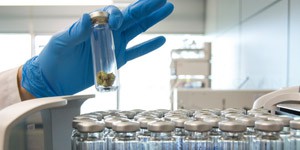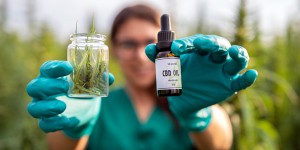By Mariano Garcia de Palau

Born in Barcelona, 17 February 1956. Graduated in medicine and surgery from the University of Barcelona in 1979. For 38 years has worked as an emergency physician in the area of occupational medicine. He became interested in cannabis by chance, and for the last 15 years has studied its therapeutic uses.
Currently he continues to advise on cannabinoid treatments and performs clinical work with patients, collaborates with various organizations and associations, serves as Senior Consultant for Grupo Curativa Colombia and is a spokesperson for the Spanish Medical Cannabis Observatory.
The effect of a cannabis variety is determined by the percentage of cannabinoids, terpenes, flavonoids and other active substances found in the different varieties, whether Sativa, Indica or hybrid. The different cannabinoid and terpene profiles determine the plant's strength in terms of its effects. Terpenes modulate and complement the effects of the cannabinoids, provide the flavour and smell of each variety and are responsible for the plant's resistance to predators.
Cannabinoids are chemically terpenophenols, so it is predictable that terpenes act in the same way as cannabinoids, through the endocannabinoid system's receptors, in some cases. Personally, I think that cannabinoids are the terpenes that only the cannabis plant synthesises and are not found in other varieties in the vegetable kingdom. The cannabis plant is unique in this sense. Its composition is complex with about 400 active molecules in each variety and not to mention that cannabinoids represent just 20 to 40% of the plant's components.
Since the therapeutic cannabis use has been legalised in different states in the USA, a cannabis industry has arisen that has enabled quality cannabis formulations to be administered in different ways. From a medical point of view, the possibility of administering cannabinoids with controlled doses by inhalation, orally, sublingually, rectally, and with intranasal and transdermal methods enables different methods to be used depending on the pathology to be treated and the characteristics of each patient. Many of these administration methods are already used, although it must be understood that not all formulations are suitable for any administration method. For a cannabinoid to be injected, it must be formulated specifically for this purpose, and its preparation and components must be specific for this method. There is no product currently available that can be injected. No cannabis oil can be injected!
So now let's review the characteristics of each administration method and its indications.
Terpenes and cannabinoids are volatile or semi-volatile substances, so they are quantified by chromatography. This technique is used to classify compounds from a complex mixture. Currently, high precision liquid column chromatography or HPLC is the most accurate technique for quantifying cannabis components.
The result of a chromatography indicates the quantity of each cannabinoid or terpene analysed expressed in a percentage with respect to 100% of the total weight of the sample. For a hypothetical variety or product with 10% THC, it is directly known that there is 10 mg of THC in 100 mg of sample. In 1 g there is 100 mg and so on.
In oil dilutions, the weight of 1 ml of virgin olive oil at 24° is 0.928 g, although it is usual to work with 1 ml = 1 g.
Since the different cannabinoids have different effects, as do terpenes, knowing the amount of cannabinoids and terpenes of the varieties to be used would mean that the different varieties could be used according to the disease or symptoms that the patient presents. It would always be approximate, but different cannabinoid and terpene profiles could be prescribed for the different pathologies or symptoms to be treated.
In a certain way, it enables treatment to be individualised, which is not easy, since the final effect of cannabis always depends on multiple factors. Even in the same patient, the same doses do not always have the same effect.
Given the variability in cannabinoid percentages when using the complete plant, and the difficulty in having a regular supply of herbal product to follow the treatments, standardised and correctly analysed products must be used in order to know the percentage of cannabinoids and terpenes, in addition to controlling the possible presence of contaminants such as heavy metals, pesticides, fungicides, bacteria, fungi, etc.
If the herbal material is correctly analysed, it can be used and dosed precisely, to inhale by vaporiser or dissolve and administer orally, for example.
Standardised and correctly analysed products ensure accurate dosage and peace-of-mind and safety for the patient.
The disadvantage in some cases is the economic cost, which is determined by the high doses required.
Various formulations are available on the market and there are products with CBD that meet the legal requirements to be marketed.
Cannabinoids can therefore be administered in different ways with different formats in products with CBD, duly tested.
They can be administered using different methods, although the most common is inhaling cannabis after combustion by smoking a "joint" that may or may not be mixed with tobacco.
From the therapeutic point of view, this method is not recommended in any case. When the smoke of the joint mixed with tobacco is inhaled, the following substances among others are inhaled:
Hydrogen cyanide, tar, nicotine, carbon dioxide, nitrosamines typical of tobacco, aromatic amines, nitrogen oxide, ammonia, benzopyrenes and traces of lead, selenium, arsenic, chromium and nickel among other substances. Some of these are carcinogenic and others toxic at certain doses.
It is therefore clear that the use of cannabis mixed with tobacco is not advised from the therapeutic point of view in any case and is also discouraged for recreational purposes.
It must be considered that the combustion of cannabis without mixing it with tobacco also generates carcinogenic and toxic substances, although the risks are minimised. During combustion, cannabinoids and terpenes are also lost, which are also retained in the filters, depending on their composition. Around 50 to 70% of the total cannabinoids are lost when they are consumed this way. Also keep in mind that paper, depending its composition, generates harmful substances after combustion, which are also inhaled when smoking.
From the therapeutic point of view therefore, this method is never recommended. Although the final decision is always up to the patient, who decides on the treatment to follow once having been informed and advised. I think that choosing is the patient's right.
Drug administration methods must be used according to certain criteria. It should be painless, with regular absorption and obtaining the greatest bioavailability of the product, in this case the cannabinoids. The bioavailability of a drug is more or less the ratio between the dose of the substance administered and the level that obtained in blood after a certain time, which can also be quantified.
Orally - sublingual
Cannabinoids can generally be dissolved in olive or sunflower oil and in some cases in ethanol for sublingual or intraoral administration, through the mucosa in the oral cavity. Ethanol is a good solvent for cannabinoids, although for some patients its taste is a problem and it generates an oropharyngeal burning sensation. Intraoral and sublingual mucosa enables fast absorption, although there are those who dispute this method.
The oral method presents some problems at first, and also advantages. Bioavailability in this case varies greatly and indicates that giving the same doses to different patients does not result in the same blood levels. Good availability would determine similar blood levels in patients given the same dose. With little variation in absorption, dosing would be easier. It can take about two weeks to stabilise a treatment in relation to the doses. That is why it is important to start with low doses, especially when using THC, until finding the minimum effective dose, especially if the oral method is used.
Another problem is that the effect may take some time to appear: between half an hour and up to two hours after ingestion. The variability depends on each individual, and also on the time of day and activity. The effect is also more powerful and lasting than when inhaled. Always keeping the clear doses in mind. How much more powerful? It depends on each individual and the doses. Care when consuming cannabis orally, cases that end up in the hospital are usually almost all by oral ingestion.
The duration of the effect can be from 6 to 12 hours in some cases, although this is difficult to assess objectively because many individual factors are influential. Prolonged duration of the effects can be a disadvantage depending on the patient's activity, since some cannabinoids are psychoactive and can limit abilities and control for certain tasks in daily life.
Dilutions are a very useful vehicle for oral administration because they enable accurate dosage and all the patient needs to do is to ingest a few drops of olive oil or ethanol. Olive oil is a very good solvent for dilutions. Especially in relation to preserving terpenes and cannabinoids.
There are also other encapsulated formulations and suppositories for rectal administration.
Inhaled via steamer
In the case of cannabis, the method with the best bioavailability is undoubtedly inhalation using the respiratory method, the effect is obtained in a very short time after inhalation. If a competent vaporiser is used, the method is clean, there is no combustion and no toxic derivatives or carcinogens are derived from it.
To me personally, the vaporiser inhalation method is the one that seems most suitable, although it entails the problem for many patients of having to handle herbal product, or concentrates, and obtaining quality and analysed cannabis. Currently there are competent vaporisers on the market that guarantee precision in the vaporisation temperature. This is important, because a greater range of temperature selection makes better use of the plant and means the cannabinoids can be selected to inhale in a certain way.
If the sieved plant and shredded flowers are vaporised, it must be kept in mind that the humidity of the plant should be between 65% to 75%, which favours vaporisation and minimises the risk of combustion, as well as prolonging the duration of the vaporisation session and influencing the optimum temperature of vaporisation of the cannabinoids, since each one has a different vaporisation temperature.
Above 157º-165º the THC vaporises, and the CBD over 178º to 190º, CBN at 185º, THCV at 222º, so look at the wide temperature range of 150º to 222º. Therefore, if a THC/CBD variety with a 1/1 ratio is inhaled at 157º, theoretically the THC can be administered or consumed first at 157º and then rise to 190º and vaporise the CBD. However, this process is not 100% accurate either. To get the most out of the plant in order to inhale the greatest number and quantity of cannabinoids, terpenes, flavonoids, etc., work at a maximum of 200º and check that there is no combustion or the usual smoke. The cannabis plant's terpenes generally vaporise in a range that goes from 156º to 219º, which could be considered the maximum.
Since there are vaporisers made for using extracts, in this case work at temperatures ranging from 200 to 230º given the density of the product to be vaporised.
Transdermal or percutaneous method
Another method that may be useful for some cannabis patients or users is transdermal administration, through the skin. Since cannabinoids dissolve well in fats due to their lipophilic characteristics, theoretically they should have less transdermal penetration capacity than hydrophilic substances, but cannabinoid preparations are very effective applied topically in most cases. It is easy to prepare with beeswax and oil creams for topical application. They can be used for chronic pathologies, osteoarthritis, fibromyalgia and rheumatic diseases. CBD-rich preparations also have anti-inflammatory and antiproliferative effect, so they are effective for hyperkeratotic psoriasis and dermatitis or dry eczema.
If associated with limonene cannabinoids, transdermal absorption is improved, since this terpene has the function of facilitating diffusion of other compounds through the skin, among other actions. No appreciable blood levels that may cause a psychoactive effect in the patient are detected after topical cannabinoid application. Also, topically applied formulations are usually basically rich in CBD, but if it also contains THC the effect in general is more powerful, especially the analgesic effect. The expectations of the use of topical products are limited to local processes and their effect can be an interesting complement to treatment prescribed using another method at the same time.
Rectal administration
Rectal absorption is variable and depends on various factors such as the amount of faecal content or the state of the rectal mucosa among others. Although rectal absorption supposes that the drug skips the hepatic step and goes directly to general circulation. Absorption must be made through the middle and lower haemorrhoidal veins, to skip the hepatic step, which in the case of THC would be the first metabolic step by hydroxylation at 11-hydroxy-THC, which could have a psychoactive potency up to four times higher than THC, so this method would theoretically be an alternative method to administering THC in high doses while minimising the psychoactive effect. However, it must be considered that in the correct THC formulations administered using this method, lipophilic substances are absorbed rectally, albeit slowly. It is very likely that THC should be formulated in the form of hemisuccinate, to ensure correct absorption. The conclusion that the psychoactive effect of THC when administered rectally skipping the first hepatic step disappears could be erroneous. If the effect cannot be confirmed by objective tests, could it be deduced that there is no psychoactive effect because it is not absorbed?


